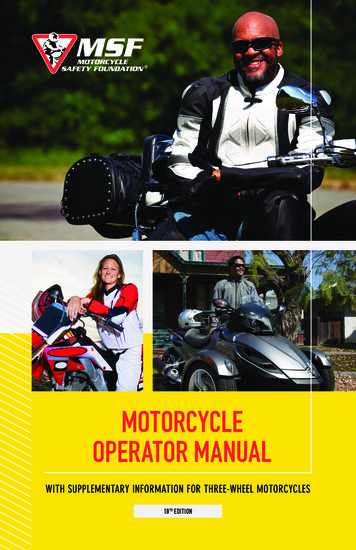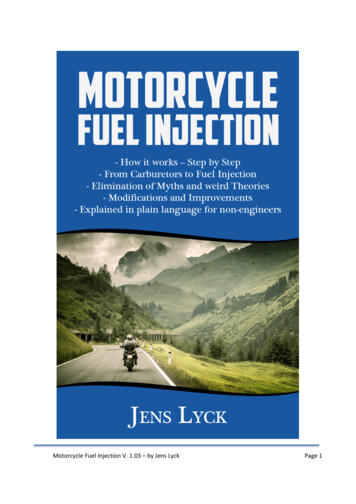
Transcription
Motorcycle Fuel Injection V. 1.03 – by Jens LyckPage 1
Chapters1.2.3.4.5.6.7.8.9.IntroductionMixing air and fuelThe carburetorMoving from carburetors to fuel injectionBasic Fuel Injection Theory (Open Loop operation)Advanced Fuel Injection (Introduction to Closed Loop and the Lambda sensor)The lambda sensor in details.Fuel Injection modificationsFuture predictionsCopyrightThis is a free book and you are allowed to download it from our www.boosterplug.com site free of chargefor your personal use.Restrictions. Commercial use of this book is not allowed. You are not allowed to distribute or publish material from the book. You are not allowed to distribute copies of the book. If you want to share the book, please refer to www.boosterplug.com, where it is available fordownload.So if anyone charged you money for this book, they are stealing from you, and anyone distributing the bookfrom another website is violating the Copyright.Motorcycle Fuel Injection V. 1.03 – by Jens LyckPage 2
1. IntroductionThe purpose of this book is to provide the ordinary motorcycle owner with a better understanding of howmodern fuel injection systems work in a motorcycle.Since we launched the BoosterPlug in 2009, I have been answering fuel injection related questions everyday, and I have been in touch with thousands of motorcycle owners from all parts of the world.The questions I have received have ranged all over the complexity scale – from very simple questions toreally advanced discussions.It all paints a picture of a very dedicated owner group with a big technical interest, but it have also shownthat there is so much incomplete information floating around: False assumptions, outdated informationfrom the first generations of electronic fuel injection, attempts to transform carburetor theory to fuelinjection, wild guesswork, etc.So during the past year I have toyed with the idea of offering a proper explanation on how modern fuelinjection systems actually works;- Partly because I can see a huge need for a book like this.- Partly because I like the idea of giving something back to the international motorcycle communitythat have been an important part of my life for more than 30 years.I have tried to keep the explanations as non-technical as possible and illustrate everything with charts tomake this rather complex topic a bit more digestible, and it’s my hope that you will enjoy reading the bookand that it may be used as a reference in the usual technical discussions among motorcyclists.I want this information to be available to everyone, so I decided to make this a free book. (Please see thecopyright details).As I’m the founder of the BoosterPlug company you may suspect that this is nothing but BoosterPlugadvertising. I’m obviously biased towards our own solution, but you will see that the vast majority of thisbook is not about the BoosterPlug at all.During the book, I have assumed that you already know the basic principle of a four stroke engine, so I willnot take you through this. If you need to learn or refresh how the four stroke engine works, there’s plentyof sources for this on the internet.That’s it – enjoy the book :-)/Jens Lyck/BoosterPlug.comMotorcycle Fuel Injection V. 1.03 – by Jens LyckPage 3
2. Mixing air and fuelAs you probably know, your motorcycle engine runs on a mix of air and fuel – or rather fuel evaporated toform a misty mixture that will ignite inside your engine.The ratio between air and fuel is important because it will have a huge influence on how the engine runs: Power – you probably guessed or already knew this JRideability – how easy and pleasant the bike is to controlEngine life – the wrong mixture can destroy your engine or reduce its life dramaticallyPollution – adding too much fuel will increase pollution.So getting the air/fuel ratio right is very important.In theory, the ideal ratio between air and fuel is 14,7:1 in a gasoline driven engine. This is called thestoichiometric mixturePlease note that this ratio is mass based, so we are talking 14,7 kg’s of air to 1 kg of fuel.As air is not very heavy, we obviously need a lot of air for every liter of fuel.Air density depends on its temperature, but for this simple calculation, we can consider the density of air tobe 1,2 gram per liter. Gasoline have a standard density of 755 grams per liter.So, one liter of gasoline has the same weight as 629,17 liters of air, and if we want to produce a 14,7:1mixture, we need 9249 liters of air for every liter of fuel. This is just to give you an idea of how much air isactually sucked into your engine for every liter of fuel that is used.AFR is commonly used as an abbreviation for ”Air/Fuel Ratio”“Richer mixture” means a higher gasoline content in the Air/Fuel Mixture, and thereby aLOWER Air/Fuel Ratio figure.“Leaner mixture” means a lower gasoline content in the Air/Fuel Mixture, and thereby aHIGHER Air/Fuel Ratio figure.Lambda value is the same as Air/Fuel Ratio, but expressed differently. A Lambda value of 1,0equals an AFR of 14,7:1, a lambda value of 0,9 equals an AFR of 0,9 x 14,7 13,23:1 etc.To keep the terms consistent in this book, I will refrain from using the Lambda valueexpression in this book – I just wanted to show the connection between AFR and Lambda.With an AFR of 14,7:1, all the fuel will be burned up inside the engine, and there will be no excess airmolecules – if the world was an ideal place.Motorcycle Fuel Injection V. 1.03 – by Jens LyckPage 4
Unfortunately, there are a number of factors that will make it impossible for the engine to run at 14,7:1: The evaporation process where air and fuel is mixed is not 100% perfectThe ideal combustion chamber shape would be perfect spherical, and the mixture would be ignitedfrom the middle of the sphere. The Combustion chamber in your engine will never be shaped likethis.Intake and exhaust channels, engine cooling and flywheel weight will have an influence too.So, the engine needs a mixture slightly richer than the ideal 14,7:1 to run properly – More on the best AFRlater.First we will have a look at the extreme rich and extreme lean mixture to see how this will affect yourengine.Running the engine too rich or too lean will obviously lower the power and the rideability of the engine, butthere’s also a big risk to destroy the powerplant. Risks with a very rich mixtureo Gasoline is a very good degreaser, and the excess fuel can wash away the oil film on thecylinder wall and make the pistons seize in the cylinder bores.o Large amount of unburned fuel will clog up the catalytic converter and destroy it.Risks with very lean mixtureo Too lean mixture will cause the air/fuel mixture to explode during the engines compressionstroke. This way you will not have the desired controlled combustion, but an explosion thatwill put a lot of extra strain on the moving parts – and destroy the engine over time.o The excess air in the very lean mixture will increase the combustion temperature a lot,which is very bad for your engine – especially the already thermally stressed exhaust valveswill suffer.AFR for highest power.The first question that pops up in AFR discussions is usually which AFR will yield the highest power.Motorcycle Fuel Injection V. 1.03 – by Jens LyckPage 5
It is not possible to provide a firm answer, because it depends a lot on the engine configuration. Thefollowing factors will influence the ideal AFR. Combustion chamber and piston head shape Cooling method Ignition system Flywheel weightModern, liquid cooled four valve engines will run a bit leaner than an air cooled, two valve engine, andmost modern engines are delivering the highest output with an AFR between 13,5:1 and 12,5:1.The engine will not lose a significant amount of power when you go a bit leaner than 13,5:1 – not until youreach the 14,7:1 mark where the power output will drop of steeply.Going richer than 12,5:1 will lower the output at a much slower rate, and as you go richer you will feel theengine becoming more and more sluggish and lazy.The graph below will show the typical relation between Power and AFR in a modern liquid cooled four valveengine.AFR for best rideability.Those of us old enough to remember when motorcycles all had carburetors, can remember how our bikeswas much easier and pleasant to ride back then. No low speed surging, no tendency to stall the engine onevery take off, and throttle pickup after braking into a corner was smooth and it was easy to apply the rightamount of throttle.It was not because the carburetor was a better solution – but the bikes was allowed to run much richerback then, and that made a hell of a difference to how the bike responded to your input – Rideability.Motorcycle Fuel Injection V. 1.03 – by Jens LyckPage 6
Therefore, the much leaner AFR in our modern fuel injected motorcycles is to blame for the poorRideability mentioned above (Low speed surging, stalls, hard and unpleasant throttle action)The modern emission standards are made for cars, which have a very big, and heavy flywheel and largerinternal rotating mass compared to the lighter and nimbler motorcycle engines.The big flywheels will make the cars accept the lean AFR fairly well, but our motorcycles suffer at lowerRPM because the rotating mass is too low to allow smooth running.As soon as the motorcycle engine reaches a certain RPM level, it will be running OK, but riding the bike incity traffic or hairpin corners is pretty horrible.The graph below will show the relation between AFR and low speed Rideability. Again, there will be slightdifferences depending on engine configuration, but the tendency will be the same on all motorcycleengines: When you make the mixture leaner, Rideability suffers long before top end power starts todecrease significantly.The AFR for optimum Rideability differs to a certain extent from the requirements for the highest poweroutput. For mixtures richer than an AFR of 13,6:1, the Power and the Rideability curve will be fairly equal. But when you are going leaner than 13,6:1, the Rideability drops of much faster than the Power.Motorcycle Fuel Injection V. 1.03 – by Jens LyckPage 7
And so what ?Modern engines are required to run with an AFR very close to 14,4:1, and if you look at the chart below it’sclear that the motorcycle engine will not be lacking top end power, but low speed Rideability is poor.If you own a car, you know that it is able to run slow without making the ride unpleasant. As mentionedearlier, this is due to the big flywheel in the car engine.On our motorcycles, we are often forced to run a lower gear than necessary in city traffic to get the RPM’sup (Which will not benefit the environment), and we face a bigger risk of finding ourselves in dangeroussituations due to engine stalls and difficult throttle handling.Motorcycle Fuel Injection V. 1.03 – by Jens LyckPage 8
The motorcycle manufacturers are using all the tricks in the book to make our engines behave justreasonably well, and the following recent inventions are all a result of the research to improve Rideability –not really a search for more top end power. Ride by wire throttle (Computer controlled throttle valves)Dual ignition (Two spark plugs per cylinder, sometime even individually controlled)CNC milled combustion chamber shapes (as opposed to the cheaper casted cylinder head shapes)Lambda sensor (O2 sensor) in the exhaust header pipeButterfly valves in the exhaust (Computer operated)Variable inlet duct length (Computer operated)But the motorcycle engine constructors can never make things perfect because the legal AFR requirementsare not made for motorcycles but for car engines with higher rotating mass, and the environmentalrestrictions are getting tighter over the years at more or less at the same pace as new developments areimplemented.The only way to cure the common Rideability problems is to make the engine run slightly richer, and the“sweet spot” AFR in a modern engine seems to be around 13,6:1.And it’s important to mention that you only need the richer mixture during idle, low RPM running andacceleration and engine braking. As soon as you maintain a steady speed on the open roads, there is nobenefit from running the engine richer than stock. Actually this would just be a waste of fuel !If you expected a graph that would show you which AFR that would give you 20% more top end power, I’llhave to disappoint you. There are virtually no top end power gains to achieve by changing the fuel injectionAFR in a modern engine, but if the AFR tweak is done correctly, it can make your bike safer and morepleasant to ride - virtually without changing overall fuel consumption.Motorcycle Fuel Injection V. 1.03 – by Jens LyckPage 9
3. CarburetorsMost of us old enough to remember motorcycles with carburetors find ourselves longing back to thesimpler days where we could understand the air/fuel mixing process and fix the carburetor in the gardenshed when something went wrong.The main reason why we loved the carburetors was threefold: We understood the technology (or thought we did)We could fix the carb ourselves when a nozzle clogged upThrottle action was soft and easy to control, as opposed to the hard, on/off like, throttle action onthe fuel injected bikes.The carburetor was a very fine mechanical instrument, but actually never completely suitable for mixing airand fuel !It may seem like a rough statement after 100 years with the carburetor, but there was a few thingsfundamentally wrong with the carburetor: Mechanical wear in jets, nozzles, needles, and slides could change the air/fuel ratio dramaticallyover time.No compensation for air pressure or air temperature.Even the best and most accurate adjusted carburetor would provide a much wider air/fuel ratio(AFR) range than the electronic fuel injection.Even if you was always running the engine in the same temperature and air pressure conditions thecarburetor would still be working across a wider AFR range than a properly programmed electronic fuelinjection.But as real life conditions are never stable, the carburetor bike would: Run richer on a hot day and leaner in cold weather. Run richer in the mountain pass and leaner near sea level Run richer on a rainy day (Low air pressure) and lean in sunshine (High air pressure)So the only reason why the carburetor actually worked was that emission standards was not present or notvery tight, so the carburetor was allowed to (and had to) use the entire air/fuel ratio range.As you will see on the AFR vs. Power chart from the last chapter, the carburetor could provide reasonableresults, and we all accepted the carburetor because we did not have better alternatives.Motorcycle Fuel Injection V. 1.03 – by Jens LyckPage 10
The entire industry had more than a hundred years of experience with the carburetor, and themanufacturers, the dealers, the mechanics and the customer was all confident with it, and if the tighteningemission regulations had not killed the carburetor, we would probably still have it on our bikes.In the early 2000’s it became increasingly harder to get carburetor bikes approved, and the new emissionstandards introduced in 2006/2007 finally killed the carburetor on road legal motorcycles.Motorcycle Fuel Injection V. 1.03 – by Jens LyckPage 11
4. Moving from carburetors to fuel injectionThe motorcycle industry was generally slow to change from carburetors to electronic fuel injection.The carburetor suppliers had a tried and tested product, and there was an entire sub-business focusing onre-jetting, tweaking, adjusting, and repairing carburetors, and everyone was happy with the situation.Electronic fuel injection was seen as much too complicated and fragile technology, difficult to service andrepair, and impossible to adjust when the customer installed a new aftermarket exhaust and air filter. Thefact that this technology was commonly used in cars seemed to make little difference During the early 80’ies, there was a few attempts by some of the Japanese manufacturers to implementfuel injection on new top end models, but they was never popular with the dealers and mechanics who hadno clue on how to work them, so they quietly reverted to carburetors and forgot all about it.BMW was the first manufacturer to seriously implement electronic fuel injection, and they did so with theK75 and K100 series that was launched in the mid 80’ies. BMW had in-house experience with fuel injectionfrom the car industry and the fuel injection equipment they used in the beginning was very similar to theequipment used in their cars. By todays standards it was not ideal for a high performance engine, but BMWhad a good starting point, and slowly the market accepted fuel injection on motorcycles as a possiblesolution.Going fast forward 10 years to the mid 90’ies, and we see that some Italian brands are now using fuelinjection on their top models. They clearly did not have the same knowledge and experience in-house asBMW, because the programming of the first fuel injections was actually quite horrible.This was not a problem that was isolated to the Italian brands, because 5 years later when the first fuelinjected Japanese motorcycles arrived, we saw the same pattern on those bikes.By the turn of the century, it was clearly a young industry and the learning curve was steep !But after year 2000, things moved fast and the motorcycle industry changed over to fuel injection with anincredible speed. They knew very well that the tighter emission standards that was announced for2006/2007 would kill the carburetor, so they had to start investing time and money in research anddevelopment of the fuel injection.In 2005, all carburetor motorcycles was older developments in their last years of production, all newmodels was fuel injected, and by 2007, virtually all new bikes was fuel injected.So 2007 was the year the carburetor passed away after more than a hundred years of more or less faithfulservice.Motorcycle Fuel Injection V. 1.03 – by Jens LyckPage 12
5. Basic Fuel Injection Theory (Open loop operation)The carburetor is mixing air and fuel by letting the air passing through the carburetor body suck up acertain amount of fuel on the way.The fuel injection system will have a throttle body (usually one per cylinder) with a butterfly valve and afuel injector. The butterfly valve is adjusting the air flow to the engine (and thereby engine speed) The fuel injector is pressing/injecting a computer-calculated amount of fuel that is mixed with theair flow.A fuel pump and a fuel pressure regulator is used to feed the fuel injector, and the amount of fuel injectedto the engine depends on the fuel pressure and how long the fuel injector is kept open. (The fuel injector isan on/off device, so there is no regulation by opening it more or less)Fuel pressure is kept stable by the pressure regulator, so the amount of fuel to be injected is controlled bykeeping the nozzle open for a shorter or longer period.The fuel injection computer (The ECU) will then decide how long to keep the fuel injector open.A few ECU’s are capable of regulating the fuel pressure as well as adjusting the fuel injector openingduration. You can also find setups with more than one fuel injector per cylinder and other variations.But these variations does not influence the basic fuel injection theory, so they will not be discussedfurther in this book.Motorcycle Fuel Injection V. 1.03 – by Jens LyckPage 13
Fuel MapThe ECU is supposed to keep the Air/Fuel Ratio (AFR) at the desired level in all situations, no matter theengine speed or the commands from the rider (How much the throttle valve is opened).So the ECU will decide how much fuel to inject based on the predefined information stored in the fuel map.The fuel map is like a big chessboard or a chart with typically 16 by 16 tiles. On one axis we have the engineRPM, on the other axis we have the throttle opening percentage.The ECU will look at the tile or cell that is matching the actual RPM and throttle valve position, and each cellcontains information on how long the fuel injector should be kept open.You will see that the cells are spaced much closer to each other at low RPM and low throttle openings. Thisis because this area is by far the hardest to control, so when the engine is operating in the lower left handside of the fuel map, even the slightest shift in RPM or throttle position will require a different amount offuel to keep the AFR steady.Motorcycle Fuel Injection V. 1.03 – by Jens LyckPage 14
As mentioned earlier, the amount of fuel to be injected is adjusted by changing the fuel injector openingduration, and the figures in the chart below is an example on fuel injector opening duration across the fuelmap.All these numbers are entered by the factory team, and this is the main programming of the ECU. If thedevelopment guys have done a proper job, the end result will be a stable AFR in all situations.Motorcycle Fuel Injection V. 1.03 – by Jens LyckPage 15
The chart below will show the result of an ideal fuel map programming. As you will see, the AFR is stable at14,4:1 across the map.(I’m not saying that 14,4:1 is the ideal AFR, just that the programming is consistent and therefore verygood)Motorcycle Fuel Injection V. 1.03 – by Jens LyckPage 16
But the world is never ideal, so in reality you will see small AFR variations across the map - like in the chartbelow.You will see that the AFR ranges from 14,3:1 to 14,5:1 across the map. This level of inaccuracy is commonand nothing to worry about – this how a fuel map in a modern production bike will look like.Motorcycle Fuel Injection V. 1.03 – by Jens LyckPage 17
If the AFR variations gets bigger, you will experience different issues when you ride the bike: Flat spots,hesitation, misfire, exhaust popping, stalling, extreme fuel consumption, etc.Fuel maps like the one in the chart below was not uncommon on the early generations of fuel injectedmotorcycles, and as you can see there are rather big AFR variations.Some bikes were worse than others and it all depended on knowledge and experience of the factory’s R&Dteam. They obviously never admitted that their bikes were less than perfect, but some of them actually hadhorrible fuel map programming.Motorcycle Fuel Injection V. 1.03 – by Jens LyckPage 18
The tighter emission requirements in 2006/2007 forced the factories to sharpen up and invest more time inthe fuel map programming, because if the map was as poor as in the example above, they could no longerget the bike approved for road use.Some manufacturers got the fuel mapping right earlier, but quite a few of them had a steep learning curvein 2005 and 2006 JSo on motorcycles from 2007 and newer the basic fuel map is pretty accurate. As mentioned in a previouschapter the 14,4:1 AFR does not make the bike perfect to ride, but the mapping itself is done with a highdegree of precision.Bottom line in this chapter is that the basic fuel map already have the potential to outperform thecarburetor, because you have much more precise control on the amount of fuel injection in differentcombinations of RPM and throttle opening. This level of control can never be obtained with a mechanicaldevice. And even though the last generation of carburetors was developed with a 100 years of knowledgeand expertise, they still found themselves outperformed by the fuel map.But we are not done yet - By including the information from additional information sources (sensors), wecan improve things further. A lot further actually!Motorcycle Fuel Injection V. 1.03 – by Jens LyckPage 19
Additional inputs.After the ECU have been looking at the fuel map to find the basic fuel injection amount, there will be anumber of adjustments to this figure before a signal is send to the fuel injectors. This is done in the add-onmodules where additional information from other sensors are taken into account.Do make a mental note on the chart below, because I will be referring to it a lot in the following chapter.In the chart you will see the fuel injection map and the typical three add on modules. In the following I’lltake you through the three modules one by one.Please note that the map and the add on modules are all sitting inside the ECU in a mix of hardware andsoftware – you will not be able to find these modules anywhere on the bike JThe first module is similar to the Choke on the carburetor – a device to provide a richer air/fuel ratio forstarting the cold engine and when the engine is in the warm up phase. (All engines requires a richer AFRwhen they are forced to operate below their usual operating temperature – which they obviously must doduring cold starts and warm up)Back in the carburetor days you had a lever on the handlebar or directly at the carburetor to apply thericher mixture when you was starting a cold engine.In the fuel injected motorcycle today, this is done automatically by the first add on module that is readingthe engine oil temperature (and sometimes also the cooling water temperature), to tell if the engine is coldor not yet at it’s usual operating temperature.This module will gradually reduce the fuel enrichment as the engine heats up, and do absolutely nothingwhen the operating temperature is reached.Motorcycle Fuel Injection V. 1.03 – by Jens LyckPage 20
Early fuel injected motorcycles are often equipped with a choke lever too, but this is only to allow therider to raise the idle speed slightly during the warm up phase.The first fuel injected bikes did not have a stepper motor to control the idle speed, so the rider had toadjust this. Today, almost all fuel injected motorcycle engines are equipped with the small steppermotor that will automatically raise idle speed during the warm up phase.The oil temperature sensor signal was still used to make the air/fuel ratio richer, but without thestepper motor, there was no way to adjust the idle speed automatically.The second and third add on module is where the fuel injection is really adding value and precision to anextent the carburetor could only dream of. Now we are able to compensate for changes in the environmentwe are riding in, and make the bike adapt to changes in air pressure and ambient temperatures. This is oneof the big advantages with fuel injection!The second add on module will adjust the injected amount of fuel to keep the AFR steady when the airpressure changes.Air pressure will be higher on a sunny day, and lower when the weather is poor – and higher at sea levelthan in the mountain passes.Atmospheric air contains more air molecules per liter (or gallon) in high-pressure conditions that in lowpressure conditions, and the input from the air pressure sensor will allow the add on module tocompensate for the changes in air pressure. This way the air/fuel ratio can be kept steady in different airpressure conditions.Sorry if this gets a bit technical – but the essence of this is that the air pressure compensation will makeyour bike perform the same at sea level or in the mountains, and if you remember how bad a carburetorbike reacted to these changes you will know that this is a major improvement.The third add on module is keeping the AFR constant when the air temperature changes.It’s more or less the same situation as in the previous module: Cold air contains more air molecules thanhot air, and the ECU is using the information from the air temperature sensor to compensate the injectedfuel amount to keep the AFR steady.Motorcycle Fuel Injection V. 1.03 – by Jens LyckPage 21
This ability to provide an automatic compensation for the shifting air pressure and air temperature, givesthe fuel injection an advantage that the carburetor can never compete with.The difference in the AFR range (Accuracy) of the fuel injection and the carburetor is partly due to the useof a fuel map that gives you a better control of the AFR, but it is mainly because the fuel injection systemgives you the automatic compensation for shifts in air pressure and air temperature.With the calculations from the fuel map and the add on modules we now have a very good qualified guesson the amount of fuel to inject to the engine in all situations.But it’s important to understand that the output signal to the fuel injector is a predetermined calculation,based on various inputs. This is called open loop operation.We do not have any feedback from the engine if the air/fuel mixture that is fed to the engine is actuallycorrect.This is already far better and more precise than what can be achieved with the carburetor and this is howmost early fuel injections worked. But it is still not 100 % perfect because of the tolerances in thecomponent specs.Motorcycle Fuel Injection V. 1.03 – by Jens LyckPage 22
Tolerances in componentsAll industrial components have a certain tolerance in the output. Some of them are really accurate whereother will have a bigger variation in output. Here are some typical tolerance figures: Fuel injectorsFuel pump pressure regulatorRPM sensorTPS sensorAir pressure sensorAir temperature sensor0-1 %3%0%1%3%1%This does not mean that all air pressure sensors are 3 % off, but the sensor will be approved in production ifit is delivering an output within /- 3% of the spec sheet figure.Most of the components are performing close to the specs, and if you sum up all the tolerances of theinvolved components, you will usually see that some variations will make the AFR slightly richer, some ofthem slightly leaner, so the end result is fairly good on most bikes.But if all the components on your bike was at the maximum tolerance and they was all pulling the AFR inthe same direction you could have a bike that is running 8% leaner or 8% richer than the preprogrammedvalue.It will be very few of the bikes that are running extremely rich or lean, but most of them will have a smalleror larger offset compared to the programmed AFR.Without the current emissions restrictions,
To keep the terms consistent in this book, I will refrain from using the Lambda value expression in this book - I just wanted to show the connection between AFR and Lambda. Motorcycle Fuel Injection V. 1.03 - by Jens Lyck Page 5 Unfortunately, there are a number of factors that will make it impossible for the engine to run at 14,7:1: .
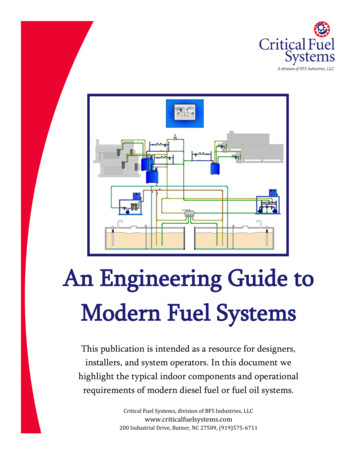


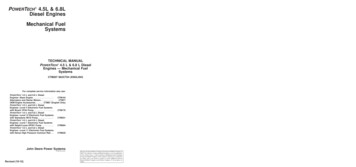
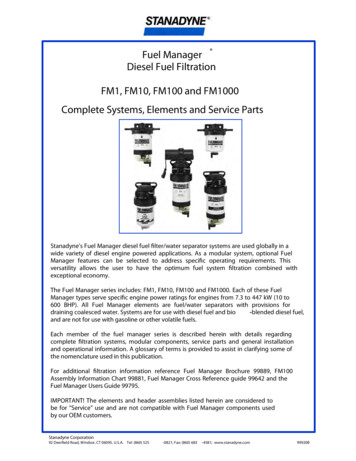

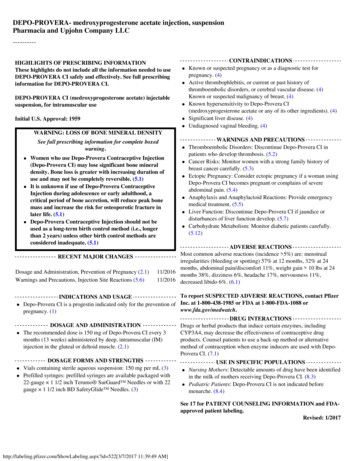
![Motorcycle Mechanic [MM] - CTEVT](/img/5/motorcycle-20-20mechanic-2010.jpg)
